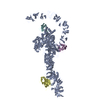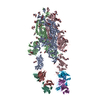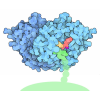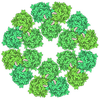[English] 日本語
 Yorodumi
Yorodumi- PDB-7v1n: Structure of the Clade 2 C. difficile TcdB in complex with its re... -
+ Open data
Open data
- Basic information
Basic information
| Entry | Database: PDB / ID: 7v1n | |||||||||
|---|---|---|---|---|---|---|---|---|---|---|
| Title | Structure of the Clade 2 C. difficile TcdB in complex with its receptor TFPI | |||||||||
 Components Components |
| |||||||||
 Keywords Keywords | TOXIN / TcdB4 / TFPI / receptor / complex | |||||||||
| Function / homology |  Function and homology information Function and homology informationExtrinsic Pathway of Fibrin Clot Formation / Transferases; Glycosyltransferases; Hexosyltransferases / host cell cytosol / endopeptidase inhibitor activity / cellular response to steroid hormone stimulus / glycosyltransferase activity / negative regulation of blood coagulation / side of membrane / cysteine-type peptidase activity / host cell endosome membrane ...Extrinsic Pathway of Fibrin Clot Formation / Transferases; Glycosyltransferases; Hexosyltransferases / host cell cytosol / endopeptidase inhibitor activity / cellular response to steroid hormone stimulus / glycosyltransferase activity / negative regulation of blood coagulation / side of membrane / cysteine-type peptidase activity / host cell endosome membrane / serine-type endopeptidase inhibitor activity / caveola / blood coagulation / toxin activity / Hydrolases; Acting on peptide bonds (peptidases); Cysteine endopeptidases / lipid binding / host cell plasma membrane / cell surface / endoplasmic reticulum / proteolysis / extracellular space / extracellular region / metal ion binding / membrane / plasma membrane Similarity search - Function | |||||||||
| Biological species |  Clostridioides difficile (bacteria) Clostridioides difficile (bacteria) Homo sapiens (human) Homo sapiens (human) | |||||||||
| Method | ELECTRON MICROSCOPY / single particle reconstruction / cryo EM / Resolution: 3.2 Å | |||||||||
 Authors Authors | Luo, J. / Yang, Q. / Zhang, X. / Zhang, Y. / Wan, L. / Li, Y. / Tao, L. | |||||||||
| Funding support |  China, 2items China, 2items
| |||||||||
 Citation Citation |  Journal: Cell / Year: 2022 Journal: Cell / Year: 2022Title: TFPI is a colonic crypt receptor for TcdB from hypervirulent clade 2 C. difficile. Authors: Jianhua Luo / Qi Yang / Xiaofeng Zhang / Yuanyuan Zhang / Li Wan / Xiechao Zhan / Yao Zhou / Liuqing He / Danyang Li / Dazhi Jin / Ying Zhen / Jing Huang / Yanyan Li / Liang Tao /  Abstract: The emergence of hypervirulent clade 2 Clostridioides difficile is associated with severe symptoms and accounts for >20% of global infections. TcdB is a dominant virulence factor of C. difficile, ...The emergence of hypervirulent clade 2 Clostridioides difficile is associated with severe symptoms and accounts for >20% of global infections. TcdB is a dominant virulence factor of C. difficile, and clade 2 strains exclusively express two TcdB variants (TcdB2 and TcdB4) that use unknown receptors distinct from the classic TcdB. Here, we performed CRISPR/Cas9 screens for TcdB4 and identified tissue factor pathway inhibitor (TFPI) as its receptor. Using cryo-EM, we determined a complex structure of the full-length TcdB4 with TFPI, defining a common receptor-binding region for TcdB. Residue variations within this region divide major TcdB variants into 2 classes: one recognizes Frizzled (FZD), and the other recognizes TFPI. TFPI is highly expressed in the intestinal glands, and recombinant TFPI protects the colonic epithelium from TcdB2/4. These findings establish TFPI as a colonic crypt receptor for TcdB from clade 2 C. difficile and reveal new mechanisms for CDI pathogenesis. | |||||||||
| History |
|
- Structure visualization
Structure visualization
| Movie |
 Movie viewer Movie viewer |
|---|---|
| Structure viewer | Molecule:  Molmil Molmil Jmol/JSmol Jmol/JSmol |
- Downloads & links
Downloads & links
- Download
Download
| PDBx/mmCIF format |  7v1n.cif.gz 7v1n.cif.gz | 432.9 KB | Display |  PDBx/mmCIF format PDBx/mmCIF format |
|---|---|---|---|---|
| PDB format |  pdb7v1n.ent.gz pdb7v1n.ent.gz | 343.4 KB | Display |  PDB format PDB format |
| PDBx/mmJSON format |  7v1n.json.gz 7v1n.json.gz | Tree view |  PDBx/mmJSON format PDBx/mmJSON format | |
| Others |  Other downloads Other downloads |
-Validation report
| Summary document |  7v1n_validation.pdf.gz 7v1n_validation.pdf.gz | 883.7 KB | Display |  wwPDB validaton report wwPDB validaton report |
|---|---|---|---|---|
| Full document |  7v1n_full_validation.pdf.gz 7v1n_full_validation.pdf.gz | 984.5 KB | Display | |
| Data in XML |  7v1n_validation.xml.gz 7v1n_validation.xml.gz | 74.4 KB | Display | |
| Data in CIF |  7v1n_validation.cif.gz 7v1n_validation.cif.gz | 111.4 KB | Display | |
| Arichive directory |  https://data.pdbj.org/pub/pdb/validation_reports/v1/7v1n https://data.pdbj.org/pub/pdb/validation_reports/v1/7v1n ftp://data.pdbj.org/pub/pdb/validation_reports/v1/7v1n ftp://data.pdbj.org/pub/pdb/validation_reports/v1/7v1n | HTTPS FTP |
-Related structure data
| Related structure data |  31628MC M: map data used to model this data C: citing same article ( |
|---|---|
| Similar structure data |
- Links
Links
- Assembly
Assembly
| Deposited unit | 
|
|---|---|
| 1 |
|
- Components
Components
| #1: Protein | Mass: 270454.000 Da / Num. of mol.: 1 Source method: isolated from a genetically manipulated source Details: isoform B4 / Source: (gene. exp.)  Clostridioides difficile (bacteria) / Gene: tcdB, toxB / Production host: Clostridioides difficile (bacteria) / Gene: tcdB, toxB / Production host:  References: UniProt: Q9EXR0, Hydrolases; Acting on peptide bonds (peptidases); Cysteine endopeptidases |
|---|---|
| #2: Protein | Mass: 28681.633 Da / Num. of mol.: 1 Source method: isolated from a genetically manipulated source Source: (gene. exp.)  Homo sapiens (human) / Gene: TFPI, LACI, TFPI1 / Production host: Homo sapiens (human) / Gene: TFPI, LACI, TFPI1 / Production host:  Homo sapiens (human) / References: UniProt: P10646 Homo sapiens (human) / References: UniProt: P10646 |
| Has protein modification | Y |
| Sequence details | These conflicts are isoform B4 sequence. |
-Experimental details
-Experiment
| Experiment | Method: ELECTRON MICROSCOPY |
|---|---|
| EM experiment | Aggregation state: PARTICLE / 3D reconstruction method: single particle reconstruction |
- Sample preparation
Sample preparation
| Component |
| ||||||||||||||||||||||||||||
|---|---|---|---|---|---|---|---|---|---|---|---|---|---|---|---|---|---|---|---|---|---|---|---|---|---|---|---|---|---|
| Molecular weight | Experimental value: NO | ||||||||||||||||||||||||||||
| Source (natural) |
| ||||||||||||||||||||||||||||
| Source (recombinant) |
| ||||||||||||||||||||||||||||
| Buffer solution | pH: 8 | ||||||||||||||||||||||||||||
| Specimen | Embedding applied: NO / Shadowing applied: NO / Staining applied: NO / Vitrification applied: YES | ||||||||||||||||||||||||||||
| Specimen support | Grid material: GOLD / Grid mesh size: 300 divisions/in. / Grid type: Quantifoil R1.2/1.3 | ||||||||||||||||||||||||||||
| Vitrification | Cryogen name: ETHANE |
- Electron microscopy imaging
Electron microscopy imaging
| Experimental equipment |  Model: Titan Krios / Image courtesy: FEI Company |
|---|---|
| Microscopy | Model: FEI TITAN KRIOS |
| Electron gun | Electron source:  FIELD EMISSION GUN / Accelerating voltage: 300 kV / Illumination mode: FLOOD BEAM FIELD EMISSION GUN / Accelerating voltage: 300 kV / Illumination mode: FLOOD BEAM |
| Electron lens | Mode: BRIGHT FIELD |
| Image recording | Electron dose: 50 e/Å2 / Film or detector model: GATAN K3 (6k x 4k) |
- Processing
Processing
| CTF correction | Type: NONE |
|---|---|
| 3D reconstruction | Resolution: 3.2 Å / Resolution method: FSC 0.143 CUT-OFF / Num. of particles: 227825 / Symmetry type: POINT |
 Movie
Movie Controller
Controller









 PDBj
PDBj







